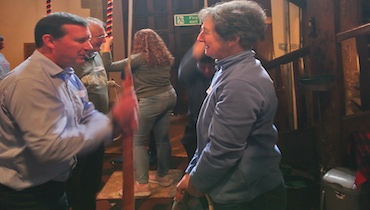M1: 30 Mar 2019 - Westerham
On a sunny morning, 13 ringers gathered at the church of St. Mary in Westerham, Kent, for the ART module 1 course, Teaching Bell Handling. The attendees ranged from some very experienced teachers to those of us who hadn’t taught at all. After a welcome cup of tea or coffee we began with a theory session from Gill, looking at the different ways of learning and teaching - most of which can applied in many different fields. The need to be flexible and adapt one’s teaching methods if needed, to give constant feedback, to provide plenty of opportunities for the learner to practice the skills thus developing muscle memory, and for the teacher to observe closely to correct mistakes before they become ingrained were all strongly stressed.
From there we went to our first practical session, which covered a learner’s very first time on a rope and some different ways to introduce backstrokes and handstrokes. These were new even to the more experienced among us, and gave much food for thought. We all took turns being “teacher” and “learner” and swapped partners so that we all got to experience different learning styles. The next session was more theory, this time learning what makes a good teacher. The importance of good communication, observation, giving constructive feedback and motivating learners were all emphasised. After that we went back to the bells to learn how to teach people to put the handstroke and backstroke together. This was where the significance of the ART “Whole - Part - Whole” approach became clearest, as we saw how the individual elements can be broken down and put together again as many times as needed, until the learner becomes proficient.
After a welcome lunch break we had a practical session on raising and lowering, again breaking the process into pieces so that each skill can be learned thoroughly before combining them. This was a bit of a workout for those on the back bells, as Westerham is quite a heavy ring!
The last theory session focused on some common handling problems and ways to fix them. Floating hands, straight elbows, backstrokes cut short, and other familiar problems were illustrated in a useful film. We then went back to the bells to demonstrate how we would tackle these problems. Lastly, Gill taught us what to do in the event that someone loses control of the rope, and some of us had a go at getting things back under control. This was quite a reassuring session for those of us who hadn’t had experience of catching a stray rope.
After a final summary of the main points of the day, and an overview of the many resources available through ART, we left to think over all that we’d learned, and to make plans for our future steps into teaching. It was a very good day, with a nice balance of theory and practical work, and I think we all found Gill to be an engaging and inspiring teacher.
Claire Shapiro

Course Tutor: Gillian Hughes

Teaching Bell Handling
Practical advice for teachers, right from the first lesson.